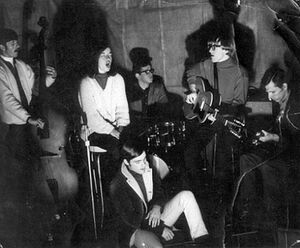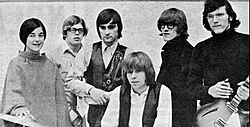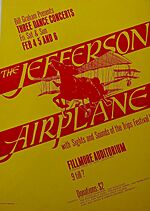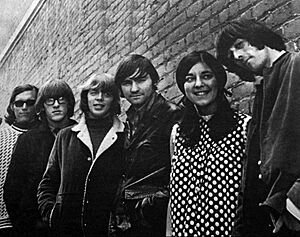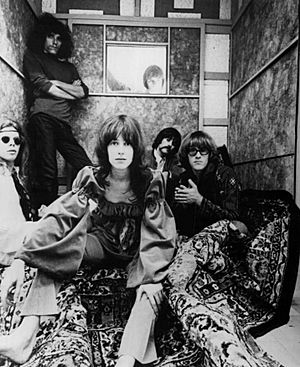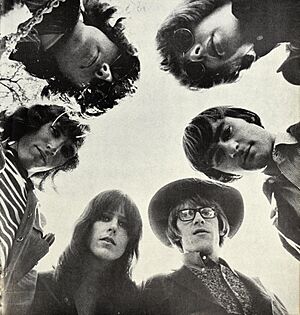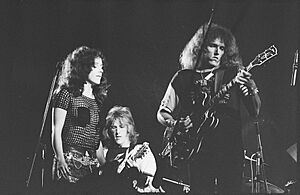Jefferson Airplane facts for kids
Quick facts for kids
Jefferson Airplane
|
|
|---|---|
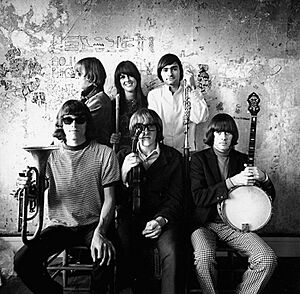
Jefferson Airplane photographed by Herb Greene in his dining room, San Francisco, late 1966; top row from left: Jack Casady, Grace Slick, Marty Balin; bottom row from left: Jorma Kaukonen, Paul Kantner, Spencer Dryden
|
|
| Background information | |
| Origin | San Francisco, California, U.S. |
| Genres |
|
| Years active | 1965–1973, 1989, 1996 |
| Labels |
|
| Associated acts |
|
| Past members |
|
Jefferson Airplane was an American rock band that started in San Francisco in 1965. They were pioneers of psychedelic rock, a style of music that became popular in the 1960s. The band helped define the "San Francisco Sound" and was the first group from the Bay Area to become famous worldwide.
They performed at major music events like the Monterey Pop Festival (1967), the first Isle of Wight Festival (1968), Woodstock (1969), and Altamont Free Concert (1969). Their 1967 album, Surrealistic Pillow, was very important during the "Summer of Love". Two songs from that album, "Somebody to Love" and "White Rabbit", are considered some of the greatest songs ever.
The band's most famous lineup, from 1966 to 1970, included Marty Balin (vocals), Paul Kantner (guitar, vocals), Grace Slick (vocals, keyboards), Jorma Kaukonen (lead guitar, vocals), Jack Casady (bass), and Spencer Dryden (drums). This lineup was honored in the Rock and Roll Hall of Fame in 1996. After 1972, Jefferson Airplane members went on to form other groups, like Hot Tuna and Jefferson Starship. Jefferson Airplane received a Grammy Lifetime Achievement Award in 2016.
Contents
The Story of Jefferson Airplane
Starting the Band in San Francisco (1965-1966)
In 1965, Marty Balin wanted to create a new band. He was inspired by the growing folk rock music style. Balin also helped open a nightclub in San Francisco called the Matrix, where his new band could perform.
Balin met Paul Kantner, another folk guitarist and singer, and invited him to join. Kantner had played folk music in the San Francisco area for years. They then looked for more musicians to complete their group.
They brought in Bob Harvey on bass and Jerry Peloquin on drums. Balin and Kantner also wanted a female singer. They found Signe Toly Anderson, who became a co-lead singer. Anderson sang with the band for about a year and was on their first album.
Next, they needed a lead guitarist. Kantner asked his old friend, Jorma Kaukonen, a blues guitarist, to join. Kaukonen liked the band's sound and became a member in June 1965. Kaukonen is also credited with coming up with the band's unique name, "Jefferson Airplane."
The band started performing at The Matrix in August 1965. Their music blended folk, blues, and rock and roll. They quickly became popular in San Francisco. Soon after, Jerry Peloquin left the band. Skip Spence took over as drummer. In October 1965, Jack Casady, a friend of Kaukonen's, replaced Bob Harvey on bass.
The band's performances improved quickly. Music journalist Ralph J. Gleason praised them, helping them gain more attention. By late 1965, Jefferson Airplane signed a record deal with RCA Victor.
Their first single was "It's No Secret." After recording their first album, Skip Spence left the band. Spencer Dryden became the new drummer in July 1966.
The debut album, Jefferson Airplane Takes Off, was released in August 1966. It featured many songs written or sung by Marty Balin. The album also included covers of other artists' songs. RCA Victor made some changes to the lyrics of a few songs on the album.
Signe Anderson left the band in October 1966 after her daughter was born. Her last show was at the Fillmore.
Becoming Famous: The Surrealistic Pillow Era (1966-1967)
The very next night, Grace Slick joined Jefferson Airplane as the new singer. Slick had previously sung with a band called The Great Society, which often played with Jefferson Airplane.
Grace Slick's arrival was a big moment for the band. She had a powerful voice that fit perfectly with their psychedelic rock sound. She also brought two songs from her previous band: "White Rabbit" and "Somebody to Love". Both songs became huge hits for Jefferson Airplane.

In early 1967, the band visited the East Coast for the first time. On January 14, they performed at the "Human Be-In" in Golden Gate Park. This was a key event leading up to the "Summer of Love".
The band's second album, Surrealistic Pillow, was recorded in just 13 days. Released in February 1967, it quickly made Jefferson Airplane famous around the world. The album reached No. 3 on the Billboard charts and sold over a million copies. The album's name was suggested by Jerry Garcia of the Grateful Dead, who said it sounded "as surrealistic as a pillow is soft."
"Somebody to Love" and "White Rabbit" became top 10 hits in the U.S. By late 1967, Jefferson Airplane was one of America's most popular groups.
A highlight of this period was their performance at the Monterey Pop Festival in June 1967. This festival helped many bands gain national and international fame. Jefferson Airplane also appeared on popular TV shows like The Tonight Show Starring Johnny Carson and The Ed Sullivan Show. Their performance on The Smothers Brothers Comedy Hour was notable for its use of special video effects.
Changing Sounds and Political Messages (1967-1970)
After Surrealistic Pillow, Jefferson Airplane's music began to change. Their third album, After Bathing at Baxter's, released in December 1967, showed a deeper dive into psychedelic rock. This album featured longer songs and more complex musical parts.
Paul Kantner and Grace Slick became the main songwriters during this time. The band's sound became heavier. In February 1968, Bill Thompson became the band's permanent manager. He helped secure the band's finances and bought a large house in San Francisco that became their office and home.
In mid-1968, the band toured Europe, playing alongside the Doors. In a memorable incident at a concert in Amsterdam, Doors singer Jim Morrison became unwell on stage and was unable to perform.
Jefferson Airplane's fourth album, Crown of Creation, released in September 1968, was also very successful. It reached No. 6 on the album charts. Grace Slick's song "Lather" is said to be about drummer Spencer Dryden's 30th birthday.
In October 1968, Grace Slick caused a stir on The Smothers Brothers Comedy Hour when she appeared in blackface and raised her fist in a salute after singing "Crown of Creation."
In November 1968, the band performed on a rooftop in Manhattan for a film. The performance was stopped by police because they didn't have a permit.
In February 1969, the live album Bless Its Pointed Little Head was released, featuring recordings from their 1968 concerts. It became another Top 20 album for the band.
During a break in Jefferson Airplane's touring, Jorma Kaukonen and Jack Casady started their own band, Hot Tuna. They played several shows and often opened for Jefferson Airplane.
In April 1969, the band began recording their next album, Volunteers. This was the last album with their classic lineup. The album's release was delayed due to disagreements with their record label over song lyrics and the original title, Volunteers of Amerika. The title was later shortened to Volunteers.
In August 1969, Jefferson Airplane performed at the Woodstock Festival. The new album, Volunteers, was released in November 1969. It was their most political album, expressing their views against the Vietnam War and reflecting the changing times in the United States. Famous songs from this album include "Volunteers" and "Wooden Ships".
Changes and New Beginnings (1970-1974)
Spencer Dryden left the band in February 1970. He was replaced by Joey Covington, who had already played percussion on Volunteers. Later that year, veteran jazz violinist Papa John Creach joined both Hot Tuna and Jefferson Airplane.
In 1970, the band released the single "Mexico". Grace Slick's "Mexico" criticized government policies. Paul Kantner also started exploring science fiction themes in his work, releasing his first solo album, Blows Against the Empire, which was credited to "Paul Kantner/Jefferson Starship". This album was even nominated for a Hugo Award.
1971 brought many changes. Grace Slick and Paul Kantner had a daughter, China Wing Kantner. In April 1971, Marty Balin officially left Jefferson Airplane, seeking a healthier lifestyle and pursuing different musical interests.
In May 1971, Grace Slick was in a car accident but recovered after a few months.
In September 1971, the album Bark was released. It was the first release on the band's own label, Grunt Records. The single "Pretty As You Feel" was their last song to appear on the charts.
Despite continued success, there were creative differences within the band. Jorma Kaukonen and Jack Casady were increasingly focused on Hot Tuna.
Jefferson Airplane recorded one more album, Long John Silver, released in July 1972. By this time, members were deeply involved in their solo projects. Joey Covington left the band and was replaced by John Barbata on drums. David Freiberg also joined the band as a replacement for Marty Balin.
The band toured to promote Long John Silver in 1972, including a large free concert in Central Park. Their last live performances as Jefferson Airplane were at the Winterland Ballroom in San Francisco in September 1972. Marty Balin even joined them on stage for the final songs.
These Winterland shows were the last performances by Jefferson Airplane until their reunion in 1989. A live album, Thirty Seconds Over Winterland, was released in 1973. Later that year, Kaukonen and Casady fully committed to Hot Tuna.
By January 1974, Jefferson Airplane had evolved into Jefferson Starship. This new band included Kantner, Slick, Freiberg, Barbata, and Creach, along with new members.
Other Projects and Reunions
Side Projects and Spin-off Bands
Many members of Jefferson Airplane also played in other successful bands. Hot Tuna was formed by Jorma Kaukonen and Jack Casady. After Jefferson Airplane, Paul Kantner, Grace Slick, and other members formed Jefferson Starship. Later, some members also formed Starship and the KBC Band.
Reunions and Special Performances (1989-Present)
In 1989, the classic 1966–70 lineup of Jefferson Airplane (except for Spencer Dryden) reunited for a tour and released a self-titled album. The tour was very successful.
In 1996, the band's classic lineup was inducted into the Rock and Roll Hall of Fame. Many members attended and performed.
A popular TV documentary about Jefferson Airplane was broadcast in 1998, featuring interviews with band members. In 2004, a film called Fly Jefferson Airplane was released on DVD, covering their early years.
In 2015, Kaukonen and Casady performed at the Lockn' Festival to celebrate Jefferson Airplane's 50th anniversary. In 2016, Jefferson Airplane received the Grammy Lifetime Achievement Award. In 2022, the band was honored with a star on the Hollywood Walk of Fame.
Several members of the band have passed away. Spencer Dryden died in 2005. Signe Anderson and Paul Kantner both died in 2016. Marty Balin died in 2018.
Band's Style and Lasting Impact
Jefferson Airplane is known as the "quintessential San Francisco psychedelic band." They truly defined the San Francisco sound of the 1960s. Their music became a soundtrack for the counterculture of that era, with themes of anti-war and anti-establishment protest. The band's sound was a mix of folk, blues, and rock, with Jorma Kaukonen's guitar work adding a unique touch.
Band Members
- Paul Kantner – rhythm guitar, vocals (1965–1972, 1989, 1996; died 2016)
- Jorma Kaukonen – lead guitar, vocals (1965–1972, 1989, 1996)
- Marty Balin – vocals, rhythm guitar, percussion (1965–1971, 1989, 1996; died 2018)
- Signe Toly Anderson – vocals, percussion (1965–1966; died 2016)
- Bob Harvey – double bass (1965; died 2025)
- Jerry Peloquin – drums (1965; died 2022)
- Skip Spence – drums, percussion (1965–1966; died 1999)
- Jack Casady – bass, rhythm guitar (1965–1972, 1989, 1996)
- Grace Slick – vocals, piano, recorder, keyboards (1966–1972, 1989)
- Spencer Dryden – drums, percussion (1966–1970, 1996; died 2005)
- Joey Covington – drums, percussion (1970–1972; died 2013)
- Papa John Creach – violin, vocals (1970–1972; died 1994)
- John Barbata – drums, percussion (1972; died 2024)
- David Freiberg – vocals, rhythm guitar (1972)
Albums by Jefferson Airplane
- Jefferson Airplane Takes Off (1966)
- Surrealistic Pillow (1967)
- After Bathing at Baxter's (1967)
- Crown of Creation (1968)
- Bless Its Pointed Little Head (1969)
- Volunteers (1969)
- Bark (1971)
- Long John Silver (1972)
- Thirty Seconds Over Winterland (1973)
- Jefferson Airplane (1989)
See also
 In Spanish: Jefferson Airplane para niños
In Spanish: Jefferson Airplane para niños


